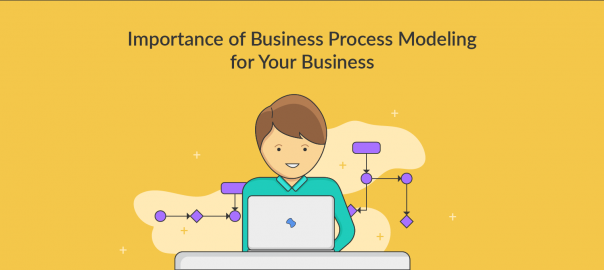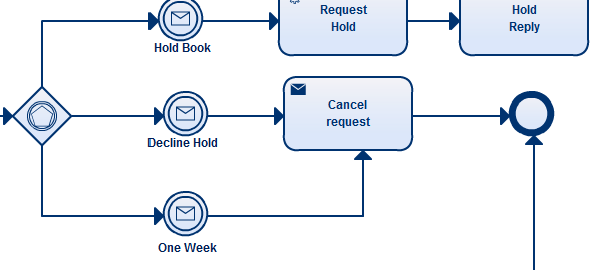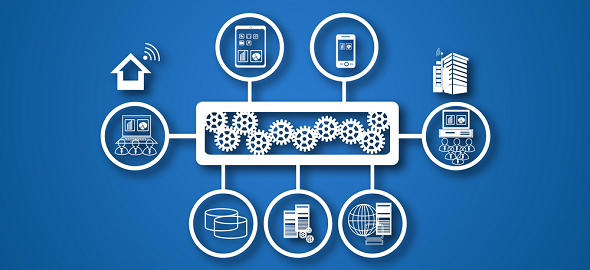In one of our previous articles about BPM we briefly touched upon various business process modeling techniques. And as promised here’s a more detailed look at various BPM techniques and how to make use of them effectively.
Business process modeling is mainly used to map a workflow so you can understand, analyse and make positive changes to that workflow or process. Usage of diagram helps you to visualize this process and make better decisions.
Use the below table to quickly navigate to different techniques.
- Business process modeling notation (BPMN)
- UML diagrams
- Flowchart technique
- Data flow diagrams
- Role activity diagrams
- Role interaction diagrams
- Gantt charts
- Integrated definition for function modeling
- Colored petri-nets
- Object oriented methods
- Workflow technique
- Simulation model
Lest start with the latest techniques.
1. Business Process Modeling Notation (BPMN)
Simply put BPMN is a graphical representation of your business process using standard objects. If you want to get more technical It can also be defined as a set of graphical objects and rules defining available connections between the objects.
BPMN consists of the following basic building blocks;
- Flow objects: events (circles), activities (rectangles with rounded corners), and gateways (diamonds)
- Connecting objects: mainly comprising arrows, these indicate sequence flow (filled arrows), message flow (dashed arrows), and associations
- Swim lanes: pools (graphic container) and lanes (sub-partition of the pool)
- Artifacts: data objects, groups, and annotations
Creately has a separate library with the latest BPMN 2.0 object included in the library. Plus you get intelligent grouping elements, professionally designed BPMN templates and much more. Check out how Creately makes it easier to model using BPMN.
The biggest advantage of BPMN is that it’s a standard with well-defined syntax. So many business analysts are familiar with it which makes collaboration much easier. Also, most modeling tools support BPMN which makes it much easier to share and edit if even using different software. All these together makes BPMN the most popular business process modeling technique at the moment. Click here to start creating any complex BPMN diagram.
Find more BPMN Examples to use for free to draw business process modeling notation diagrams.
2. UML Diagrams
UML is a modeling language mainly used for specification, visualization, development and documenting of software systems. But business professionals have adapted it as a powerful business process modeling technique.
With 14 different UML diagram types, it offers a flexible and powerful way to visualize almost any business process. They are typically used for modeling the detailed logic of a business process. In many ways, UML diagrams are the object-oriented equivalent of flow charts.
As mentioned above one of its main advantages is its flexibility. But with 14 different diagram types, some might find it difficult to understand the diagrams. Add to that the same process can be modeled using different UML diagrams. So probably not the most popular choice among analysts.
Our UML software supports drawing of all UML diagram types. We have templates, separate libraries for various UML diagrams and knowledge article to guide you through the process. Click here to start drawing UML with Creately >>
Business process modeling goes back a long time and BPMN and UML evolved from some techniques used a while back. However, some of these earlier techniques are still been used in business process modeling. Listed below are some of those techniques that are still used today.
3. Flowchart Technique
Flowcharts are probably the most popular diagram type in the world. Because it has few standard symbols it can be easily understood by many. Simplicity makes it powerful and an effective tool.In fact, BPMN can be considered as an advanced version of the basic flowchart technique. Also, most drawing software support creation of flowcharts it is used by a much wider audience as well.
Flowchart uses a sequential flow of actions and does not support a breakdown of the activities. The Flow Chart model is possibly the first process notation. It has frequently been used over many years although there is no exact date for its origin.
You can use our flowchart software to easily come up with a professional flowchart.
4. Data Flow Diagrams – Yourdon’s Technique
Data flow diagrams (DFD) show the flow of data or information from one place to another. DFDs describe the processes showing how these processes link together through data stores and how the processes relate to the users and the outside world.
They are used to record the processes analysed as a part of the design documentation. A DFD can be seen as a method of organizing data from its raw state. DFDs are the backbone of structured analysis that was developed in the early sixties by Yourdon.

A DFD diagram used in modeling done by Data Flow Diagram Tool
5. Role Activity Diagrams – RAD
Roles are abstract notations of behavior describing a desired behavior within the organization. They are often organizational functions. They also include software systems, customers and suppliers. RADs provide a different perspective of the process and are particularly useful in supporting communication. They are intuitive to read, easy to understand and presents a detailed view of the process and permitting activities in parallel.

Role activity diagram used in business process modeling created by our Activity Diagram Tool
6. Role Interaction Diagrams – RID
Activities are connected to roles in a type of matrix. Activities are shown vertically on the left axis and the roles are shown horizontally at the top. Text and symbols are used together in order to represent the process.
Although slightly more complex than flow diagrams, RIDs are fairly intuitive to understand and easy to read but they tend to be messy, with many arrows pointing left and right and are therefore quite hard to build.
Inputs to and outputs from the activities are not modeled. Therefore, important information is lost. RIDs are not as flexible as flowcharts, for example. They have quite rigid notation. But compared with other modeling techniques, RIDs are nevertheless flexible. They can be drawn using an Activity Diagram Tool
7. Gantt Charts
Gantt charts relate a list of activities to a time scale. Although it can be used to represent a process graphically it’s strength lies in the ability to monitor the current situation, project timeline, and resource allocation. Although things like dependencies can be highlighted in it the modeling part is severely lacking. Probably the reason why it isn’t popular anymore. If you’re using to monitor timelines then you’ll be pleased to know Creately supports drawing Gantt charts.
A Gantt chart is a matrix that lists on the vertical axis all the tasks or activities to be performed in a process. Each row contains a single activity identification, which usually consists of a number and a name. The horizontal axis is headed by columns indicating estimated activity duration, skill level needed to perform the activity, and the name of the person assigned to the activity, followed by one column for each period in the project’s duration. Each period may be expressed in hours, days, weeks, months, and other time units. In some cases, it may be necessary to label the period columns as period 1, period 2, and so on.
8. Integrated Definition for Function Modeling (IDEF)
IDEF is a family of methods that support a paradigm capable of addressing the modeling needs of an enterprise and its business areas (IDEF, 2003). The IDEF family is used according to different applications. The most important parts are: IDEF0, IDEF1, IDEF1X, IDEF2, IDEF3, IDEF4 and IDEF5. However, for business process modeling, the most useful versions are IDEF0 and IDEF3.
9. Colored Petri Nets ( CPN )
Colored Petri nets are a graphical oriented language for design, specification, simulation and verification of systems. It is particularly well suited for systems that consist of a number of processes, which communicate and synchronize.
Colored nets are extended Petri nets in which symbols are differentiated by ‘COLORS’. A CPN model consists of a set of modules which each contain a network of places, transitions and arcs. The graphical representation makes it easy to see the basic structure of a complex CPN model, i.e. to understand how the individual processes interact with each other. CP-nets have a formal, mathematical representation with a well-defined syntax and semantics. This representation is the foundation for the definition of the different behavioral properties and the analysis methods.
10. Object Oriented Methods
This method is based on three concepts: objects that represent a real-world entity. An object has a state, i.e. one of the possible conditions in which the object may exist represented by the values of the properties (attributes). State changes are reflected by the behavior, i.e. how an object acts and reacts determined by the set of operations the object can perform on itself, and also knowing its interface, functions and methods. A set of similar objects is called class. For example, the attributes for the class animal are having four legs and a tail. Its behaviors are sleeping and eating. Then possible instances or objects of the class animal are cat, elephant, and horse.
Finally, messages are requests for the receiver objects to carry out the indicated method or behavior and return the result of that action to the sender objects. States change through behavior when the object receives a message. There are many different techniques based on OO. Unified Modelling Language (UML) is considered the standard OO modeling language. Coad and Yourdon’s method precedes UML.
11. Workflow Technique
Workflow is a flow of tasks between computer applications or people in an organization. Two or more members of a workgroup to reach a common goal can define a workflow as well as any task performed in series or in parallel. The work flow is more than a technique to model a process. It is a method to analyze and improve a process, including its modeling.
The workflow development process uses work flow models to capture the relevant information of the processes. This process comprises four stages: Information Gathering, Business Process Modelling, Work flow Modelling, Implementation and Verification & Execution. You can get started easily using our workflow diagram templates.
12. Simulation
Simulation model comes in handy when you want to study a complex real-world system. You want to learn more about the system to make an informed decision but the complexity of the system prevents you from doing that directly.
Therefore you proceed indirectly by creating and studying another entity (the simulation model), which is sufficiently similar to the real-world system. Simulation can have many forms (for example, discrete-event simulation, continuous simulation, system dynamics, Monte-Carlo simulation, qualitative simulation, etc.).
Final Thoughts on Business Process Modeling Techniques
Most of the legacy systems are outdated or used sparingly. However, it must be noted that some of them are used far more effectively in other industries and for different purposes.
For example, Gantt charts are not very effective as a business process modeling technique but they are extremely useful to monitor timelines in complex projects. Similarly, flowcharts are great to quickly describe uncomplicated processes. One might argue BPM helped popularize those techniques.
Hope now you have a good understanding of the BPM techniques. We’ll be discussing the importance of the BPM methodology through our next article.















how do Use a process flow technique to explain each of the CERTs working model.
Very helpful, would anyone know how to get Business process modeling notation (BPMN) certification, And if there is an online study/ certification option
how to make role activity diagram using any software for business processes.
Thanks for the article. What kind of modelling methodologies are used for Smart Process Automation (SPA) and Robotic Process Automation (RPA)?
Where are the references? Most the above mentioned information was written from “Aguilar-Saven, R.S., 2004. Business process modelling: Review and framework. International Journal of production economics, 90(2), pp.129-149.”
Not good.
it is good material, it has improved my understanding of BPM
Thanks for the examples. I wonder if that UML diagram is usually true for companies? What if there’s a need for CSR? What if there are defects on the product? I understand that it’s a basic sample, it’s almost an accurate model but I quickly remembered my Mass Comm lessons before I changed my course.
I am a CS B.E student and i am looking for mathematical model for bussines process mapping web application.Will u please help….
Thanks. Good article. Supported me to improve my knowledge om BPMT
I’m CS student,
And I found that creately is very helpful in developing UML Diagram.
please a need help in designing an ER schema